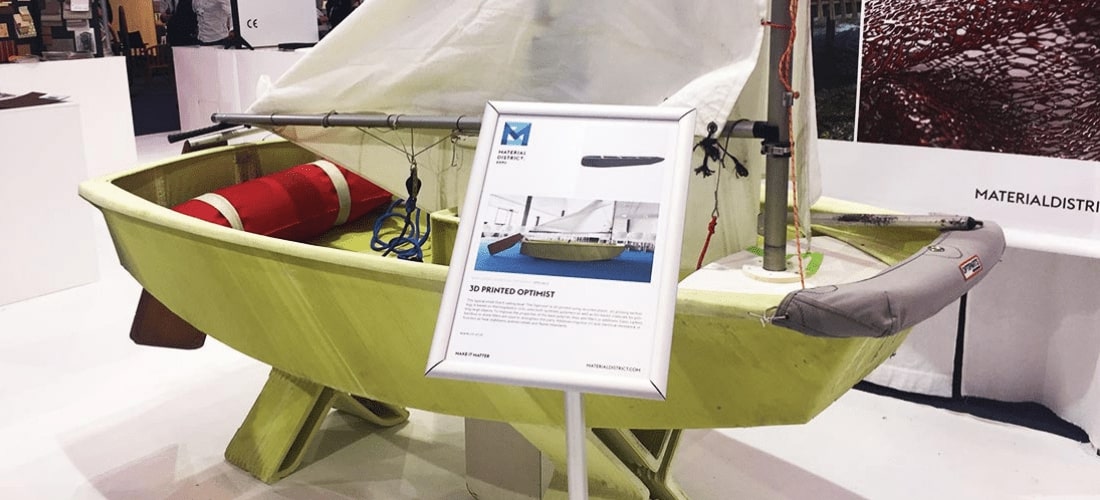New dimension in marine manufacturing reduces cost and increases productivity
A walk around the Material District Expo at METSTRADE is always inspiring, with a whole range of new materials and their applications to explore. 2018 was no exception and I was particularly intrigued to see a 3D printed Optimist sailing dinghy.
This is unlikely to be the prettiest Optimist ever made, but that would be to miss the point. It was a striking demonstration of the capabilities of Dutch firm 10XL, which has expanded its 3D printing capacity to cope with single items up to 6m long by 2m x 1.5m width and height. This Dordrecht-based company is experimenting with additive and subtractive manufacturing combined in one hybrid system, and with the use of recycled plastics and bio-based materials for printing and a whole range of materials as fillers. It has completed several other marine-based projects, including hull moulds. Suddenly you see how a designer in one country could simply hit a button and output his dinghies anywhere in the world without shipping a component.
3D printing has been permeating the marine industry for some time
Many manufacturers were quick to adopt relatively low-cost semi-professional machines as they emerged a few years ago. Their ability to rapidly prototype small components has already transformed product development paths and opened whole new horizons.
There have been some learning curves, such as the potentially false assumption that plastic components emerge micrometer perfect to a CAD CAM file, with errors due to post production shrinkage and warping of the material as it cools. However, it’s clear that the marine industry is growing in confidence with the technology and exploring the unique benefits that 3D printing can bring, including unrivalled ability to create custom and low volume, highly complex items and fabricate incredibly elaborate hollow structures for lightness and strength.
Cost of 3D printing is said to have reduced around 100 times in the past decade and speed has increased by a similar factor. The world has now the first 3D printed jet engine and we are seeing all manner of materials being worked with, from stainless steel and ceramics to concrete. There are at least nine different 3D technologies in play and no doubt more will emerge.
What is the future potential for the leisure marine industry?
Clearly high value, low volume products sit right at the core of so much of what the marine industry is dependent upon. If you can remove the often-prohibitive cost of tooling, you open the door to greater innovation and improved user experience. That will happen across more significant items too, perhaps whole boats and certainly larger sections of them.
Illustrating that point, Amer Yachts was shortlisted in this year’s IBI METSTRADE Boat Builder Awards for its 3D printed helm console used aboard the Amer 94. The result of a collaboration with Italian additive manufacturing specialist, Superfici, this component of the build is said to be perfect because it is easily adapted at the printing stage for the exact fit of instrument heads and controls that is used for each boat.
Amer sees this as just the first step. The company explains: “There is the possibility to think of larger elements integrating different materials, thicknesses and densities to satisfy the complexity connected to the mechanical requirements of progressively sophisticated boat components. In the near future we may imagine 3D printing as a feasible way to produce yachts, especially for small series or one-off productions.”
Another exciting area to explore is 3D printed spare parts. It is often prohibitively expensive and impractical to stock every item that might be required to support the peak weeks of a boating season. Some of the world’s most desirable boating waters are also the least accessible logistically, so just in time delivery is not the whole answer. Meantime the pressure on a boat users time is at a premium and the industry needs to seek ways to eliminate downtime. Locally creating parts offers exciting opportunities, and probably some relief from the current trade tariff wars too!
Two reports that are worth reading
Research in this area is being driven by commercial maritime interests, where the benefits of being able to support shipping remotely are obvious.
The Port of Rotterdam released its pilot findings on printing 3D spare parts back in January 2016. It reached largely favourable conclusions about the potential for local additive manufacturing of components that would not look entirely out of place on the shelves of a chandler or engineering shop. It also forecasts that the technology might mature well enough for parts produced this way to be certified to common commercial standards in around three years from now.
Another report well worth a read and a useful information source for this blog, is the December 2016 published Maritime Guide to 3D Print authored by Create.dk on behalf of the Danish Maritime Cluster.
Share your stories on leisure marine industry with us
Do you have an innovation, research results or an other interesting topic you would like to share with the leisure marine equipment industry? The METSTRADE website and social media channels are a great platform to showcase your stories! Let us know via metstrade@rai.nl
Are you a METSTRADE exhibitor?
Make sure you add your latest press releases to your Company Profile in the Exhibitor Portal for free exposure.





